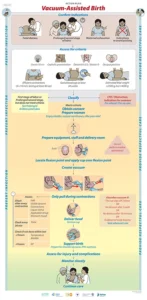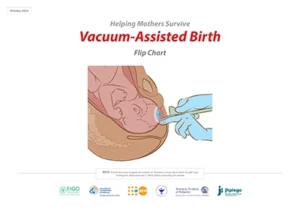Vacuum Assisted Birth
Develop the knowledge, skills, and competency to identify the need for a vacuum assisted birth, perform the procedure, and manage complications.
Introduction
Vacuum assisted birth can be lifesaving during a prolonged labor. With this training, healthcare workers learn how to identify indications and contra-indications, safely perform the procedure, and manage complications.
VAB is intended for healthcare providers who have completed the Essential Care for Labor & Birth course as well as the Prolonged & Obstructed Labor course.
The vacuum assisted birth procedure should not be attempted in clinical practice without sufficient skills practice with simulation.
Learning objectives
- Identify the need for vacuum assisted birth
- Perform vacuum assisted birth safely
- Manage vacuum assisted birth complications
- Communicate with mother and team
Duration
1 day
Facilitator-to-participant ratio
1 facilitator for every group of 3-4 participants.
Learning materials
Download and preview the materials you will need. You should also have printed materials during a training. You can order printed materials from Laerdal, or download the printing files free of charge to print locally. To calculate how many copies you need, keep in mind that there should be one facilitator for every group of six participants.
These materials are copywrited and should not be altered. Contact us for inquiries about translations and adaptations.
Action Plan
A poster showing the steps to take during care, to use both during training and as a job aid for clinical practice.
1 per group (facilitator + 3-4 participants), and enough to leave at each facility to be used in clinical care.
Select an option
- Action PlanEnglish
- Action PlanFrench

Flip Chart
Paper-based facilitation tool, with guidance for facilitators to demonstrate, lead discussions and support practice.
1 per group (facilitator + 3-4 participants)
Select an option
- Flip Chart – AfricanFrench
- Flip Chart – AfricanEnglish

Provider Guide
A booklet for every healthcare worker to use during the training and keep afterwards. For reviewing content and practicing skills over time.
1 per participant
Select an option
- Provider Guide – AfricanEnglish
- Provider Guide – AfricanFrench

Assessments
As part of the learning process, every training program includes assessments for the participants. You can download and print the assessments.
Equipment
Every group of 3-4 of participants will need these items to practice during the training. The equipment should also be available for practice in the facilities after the training.
- Birth simulator with newborn model that allows use of vacuum, we suggest MamaBirthie
- White skull (included with MamaBirthie)
- Cervical inserts (included with MamaBirthie)
- Pregnancy wheels or calendars
- Pens/pencils, paper, blank partographs . and/or client records
- BP machine
- Stethoscope (adult / newborn)
- Thermometer
- Gloves (clean and sterile)
- Fetoscope/Doppler and ultrasound gel
- Measuring tape
- Vacuum extractor and cups
- Soap or alcohol based hand rub
- Videos and projector/laptop (if using)
- Towels, baby hat, and blanket
- Scissors and/or blade
- Hemostats, clamps, ties for cord
- Basin/receiver for placenta
- Personal protection for provider
- Mock oxytocin, ampicillin, gentomycin, syringes and needle
- Suction device for newborn
- Ventilation bag and mask for newborn
- Clock/watch
- Container for safe sharps disposal
- Gauze
Templates
Download and modify these documents to fit your needs when preparing and evaluating your course.
Package contains:
- Certificate – Champion
- Practice Coordinator Evaluation
- Champions Course Agenda
- Champion Evaluation
- Training Prep Checklist
- Practice Coordinator Orientation Session Plan
- Room Layout
- Trainer Evaluation
- Certificate – Master Trainer
- Participant Sign-in Sheet
- Certificate – Trainer
- Certificate – Practice Coordinator